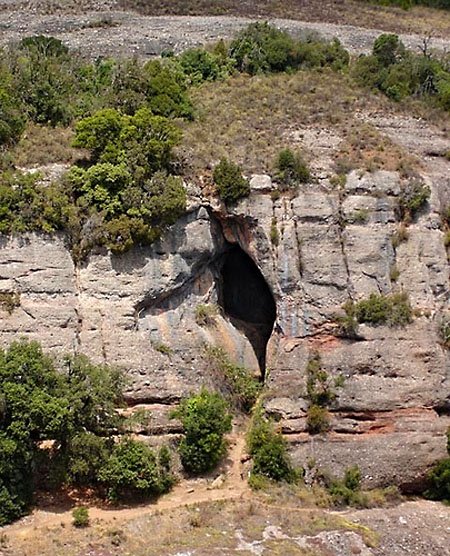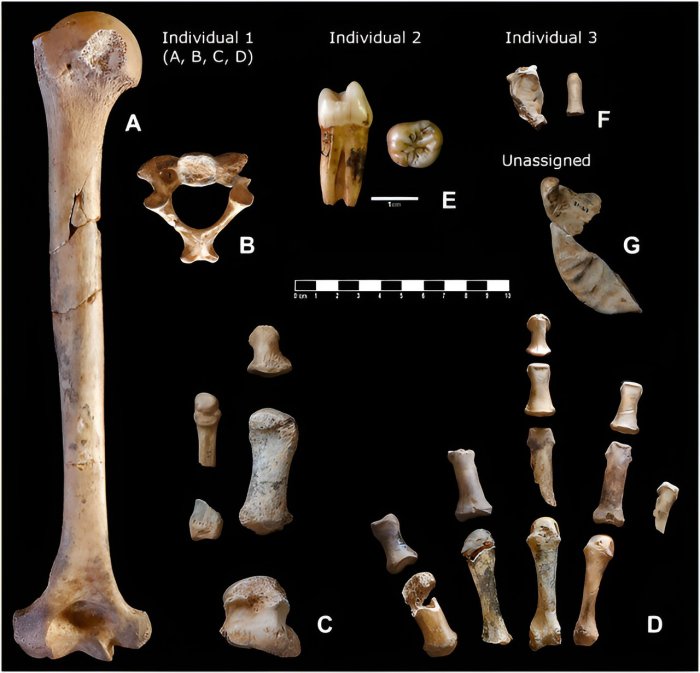Jan Bartek – AncientPages.com – Many years ago, in 1986, the Archaeology Museum of Catalonia in Spain received a box. The gift was a donation from amateur paleontologist Miguel Aznar, who, back in the late 1970s, had collected bones and several artifacts in a cave known as Cova Simanya, located in a park just outside of Barcelona.

Entrance to Cova Simanya. Credit: EspeleoÍndex – CC BY-SA 4.0
The box was put aside and more or less forgotten until 2020. A research team opened the box and studied its content. To everyone’s surprise, it turned out the box was filled with 54 Neanderthal remains corresponding to at least three individuals. It is the most important collection of Neanderthal remains in Catalonia and one of the most relevant in the Iberian Peninsula.
In their study, published in the journal Frontiers in Earth Science, the scientists explain the specimens represent an adult, probably a woman, a juvenile of about 11 or 12 years old, and a child individual of about 7 – 8 years old. “The collection encompᴀsses diverse anatomical parts including upper and lower denтιтion, mandible, vertebrae, and limb bones from both the upper and lower extremities. Attempts to extract a DNA were unsuccessful.”
According to Dr. Antonio Rosas, director of the Paleoanthropology Group of the MNCN-CSIC, of the whole set, the adult individual stands out especially, of which remains of both arms have been identified. Among them is an entire humerus, a practically complete hand, and the feet, in addition to different vertebrae and ribs.
Up to 10 teeth and a jaw fragment have also been identified. Two of these teeth belong to the juvenile individual, and the remaining eight may be compatible with the adult individual, although “the possibility that they correspond to more individuals cannot be ruled out,” Dr. Rosas added.
The ancient bones will not only help to differentiate these individuals from other species of the genus Homo but also allow us to understand better the phylogeography of the Neanderthals that populated Europe before the arrival of our species, Homo sapiens.
According to Dr. Rosas, “the fossils from Cova Simanya will help clarify the role that the Iberian Peninsula has had in the complex evolutionary history of Neanderthals.” As Dr. Rosas, who is one of the leading international experts on Neanderthals, pointed out, “today we begin to know. “There are different lineages of this extinct species, but, at this time, we still do not know the reasons for how and where they originated.”
“The first dating carried out indicates that the presence of Neanderthals in the Simanya Cave is older than the Carbon 14 limit; that is, prior to 50,000 years,” Dr. Juan Ignacio Morales, co-director of the excavations and researcher at IPHES-CERCA and SERP-UB said. Alternative dating techniques are currently being carried out that should allow the age of the remains to be determined with better precision, the researcher points out.
“The 14C chronology provided by charcoals from our excavations are compatible with those from the charcoals included in the sediment samples ᴀssociated to the human remains from the “Museum Collection,” potentially placing Simanya Neanderthals beyond 49,000 years BP.
A minimum age of circa 42,000 cal BP has been obtained for the paleontological ᴀssemblage that is also present in the layer O300-PO400. The discrepancy between both ages is consistent with the open character of the layer that could have been deposited during a relatively long period including different time-segregated events,” the scientists write in their study.

Foremost Neanderthal remains found at the Simanya Gran gallery from Cova Simanya (Barcelona, Spain). Skeletal remains are distributed according to their attribution to specific individuals.(A) Left humerus; (B) shaft, caudal view; (C) bones of the foot; (D) bones of the right hand;(E) upper P3 and M3; (F) fragment of the atlas and first phalanx of the hand; and (G) fragment of the ascending branch. Credit: Frontiers in Earth Science (2023). DOI: 10.3389/feart.2023.1230707
The Neanderthals were not the only ones to use the cave. Scientists have discovered that the cavity also served as a hibernation refuge for both the brown bear and the cave bear. The animals used the cave until at least 42,000 years ago. Much later, the cave was used sporadically from the Neolithic until much more recent times.
The Cova Simanya (Sant Llorenç Savall), located in the Sant Llorenç del Munt i de l’Obac Natural Park, is more the 300 meters in length and, due to its accessibility, it has been one of the most visited cavities in Catalonia. It is a unique place where scientists can learn plenty about the Neanderthals.
The proximity of the Simanya Cave to other Middle Paleolithic archaeological sites, such as the Coves del Toll (Moià), the Abric Romaní (Capellades), or the Cova Gran de Collbató, clearly shows that Central Catalonia was a key territory for activities and settlements. of Neanderthals during the Late Pleistocene.
The study was published in the journal Frontiers in Earth Science
Written by Jan Bartek – AncientPages.com Staff Writer





